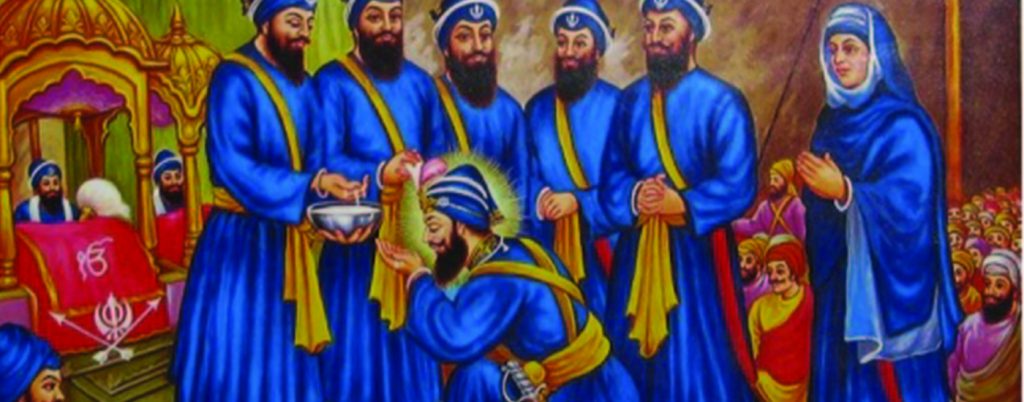
1. Guru Nanak Dev Ji: The Lightbearer (1469–1539)
Birth & Divine Purpose:
Born in Nankana Sahib (now Pakistan) in 1469, Guru Nanak Dev Ji emerged as a spiritual revolutionary. Even as a child, he challenged caste oppression and ritualistic practices, asking: “Why oppress the weak when God resides in all?”
Divine Revelation at 30:
During a transformative bath in the Kali Bein river, Guru Nanak vanished for three days, returning with the proclamation:
“Na koi Hindu, na koi Musalman” (There is no Hindu, no Muslim)—only the One Divine Light permeating all.
Three Pillars of Sikhi:
- Naam Japna: Meditate on God’s name to transcend ego.
- Kirat Karni: Earn honestly through hard work.
- Vand Chakna: Share resources selflessly.
Udasis (Divine Journeys):
For 24 years, Guru Nanak traveled over 28,000 km—from Tibet to Mecca, Sri Lanka to Baghdad—dialoguing with scholars and saints. He:
- Slept at Mecca’s mosque, turning his feet away from the Kaaba to show God is everywhere.
- Fed starving villagers in Bengal by making barren land yield crops.
2. The Nine Gurus Who Shaped Destiny
A lineage of divine wisdom and sacrifice:
Guru Angad Dev Ji (1504–1552):
- Invented Gurmukhi script to democratize spiritual knowledge.
- Institutionalized Langar, where emperors and laborers ate together.
Guru Amar Das Ji (1479–1574):
- Abolished sati and purdah, declaring women equal.
- Built the Baoli at Goindwal, a sacred well with 84 steps symbolizing liberation.
Guru Arjan Dev Ji (1563–1606):
- Compiled the Adi Granth (now Guru Granth Sahib), weaving hymns from Hindu and Muslim saints.
- Constructed Harmandir Sahib (Golden Temple) with doors facing all four directions—a beacon of inclusivity.
- Martyrdom: Tortured on hot plates by Mughals, he prayed: “Your Will is Sweetness.”
Guru Tegh Bahadur Ji (1621–1675):
- Beheaded in Delhi’s Chandni Chowk for defending Hindus’ right to practice their faith.
- Legacy: “He protected not Sikhs but the tilak (religious mark) and janeu (sacred thread) of others.”
Guru Gobind Singh Ji (1666–1708):
- 1699 Vaisakhi: Created the Khalsa, initiating the Panj Pyare (Five Beloved Ones) with Amrit.
- Five Ks:
- Kesh: Unshorn hair—accepting God’s will.
- Kirpan: Sword to defend truth.
- Kara: Steel bracelet—a reminder of eternal unity.
- Kanga: Comb—discipline amidst chaos.
- Kachera: Undergarment—moral restraint.
- Declared the Guru Granth Sahib as the Eternal Guru.
3. The Khalsa: Spiritual Warriors of Truth
1699: The Birth of a Sovereign Identity
At Anandpur Sahib, Guru Gobind Singh Ji tested devotees, demanding heads. Five stepped forward—a barber, a farmer, a shopkeeper, a water-carrier, and a tailor—proving courage transcends caste.
Khalsa Code:
- Sant-Sipahi: Saint-soldier—compassionate yet fearless.
- Degh Tegh Fateh: Victory through charity and justice.
- Waheguru Ji Ka Khalsa, Waheguru Ji Ki Fateh: The Khalsa belongs to God; victory belongs to God.
4. Empire & Resistance
Banda Singh Bahadur (1670–1716):
- Led Sikhs to overthrow Mughal tyranny, establishing the first Sikh rule.
- Issued coins inscribed “Deg-o-Teg-o-Fateh” (Kitchen, Sword, Victory).
Maharaja Ranjit Singh (1780–1839):
- The Lion of Punjab: Built a secular empire from Kabul to Kashmir.
- Gilded Harmandir Sahib, creating the “Golden Temple.”
- Employed European generals while preserving Sikh values.
5. Modern Sikhism: A Global Tapestry
Colonial Era & Freedom Struggle:
- Bhagat Singh (Sikh revolutionary) inspired India’s independence movement.
- Komagata Maru (1914): Sikhs challenged racist Canadian immigration laws.
Partition & Beyond:
- 1947: Sikhs endured mass migration and violence, yet rebuilt Punjab.
- Diaspora: Today, 30+ million Sikhs worldwide excel in farming (California), medicine (UK), and tech (Silicon Valley).
6. Sikhism’s Gift to Humanity
Universal Values:
- Langar: 80+ million free meals served daily in Gurdwaras globally.
- Environmental Stewardship: Guru Har Rai Ji pioneered wildlife conservation.
Iconic Symbols:
- Nishan Sahib: The saffron flag waves at every Gurdwara, signaling sanctuary.
- Guru Granth Sahib: The only scripture that includes writings from diverse faiths.
7. Festivals: Celebrating Faith & Freedom
- Vaisakhi: April 13—Khalsa’s birth + harvest festival.
- Bandi Chhor Divas (Diwali): Guru Hargobind freed 52 Hindu kings from Gwalior Fort.
- Gurpurabs: Full-moon readings of Guru Granth Sahib illuminate cities.
“The Khalsa Is God’s Own Image”
From Guru Nanak’s hymns to the Khalsa’s global seva, Sikhism remains a lighthouse of love, justice, and oneness. As Guru Gobind Singh Ji vowed:
“Where there are Sikhs, there will be Dharma.”
ਵਾਹਿਗੁਰੂ ਜੀ ਕਾ ਖਾਲਸਾ, ਵਾਹਿਗੁਰੂ ਜੀ ਕੀ ਫ਼ਤਹਿ 🙏